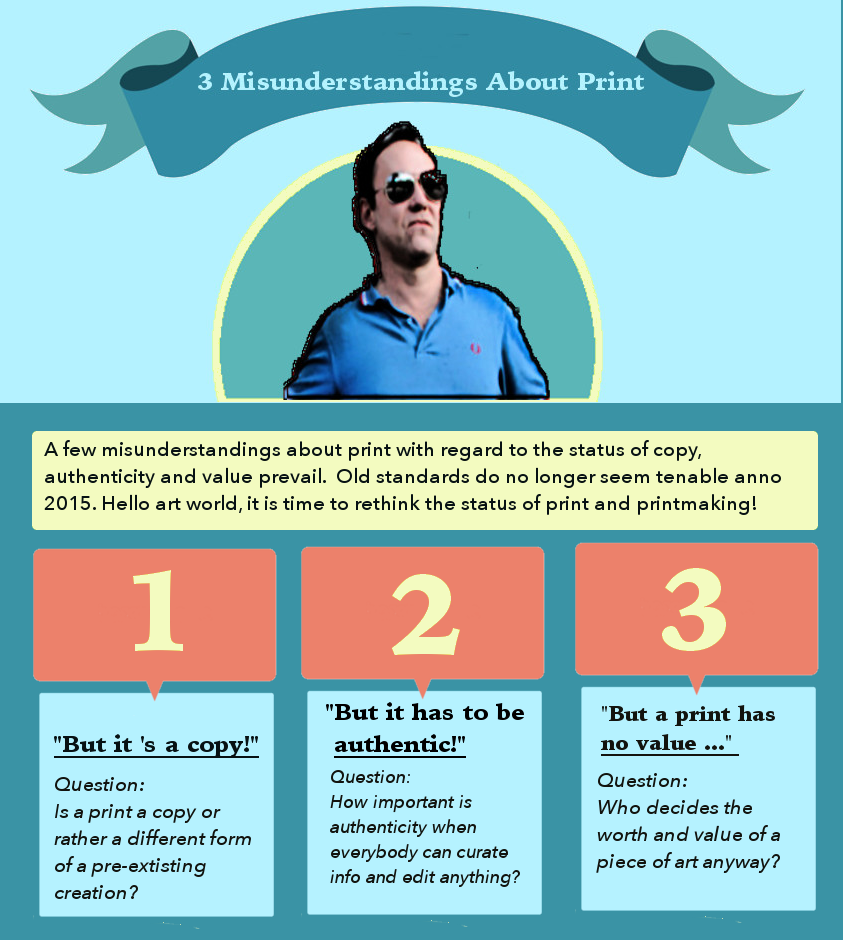3 Common Misunderstandings About Print
As printmakers, we Zartists have to deal with a lot of old-school presumptions about the art of printmaking. The three most prevailing misconceptions regard its status as a ‘copy’, the notion ‘authenticity’ and its ‘value’. Hello art world! It is time to dust of ideas from before the turn of the century and start to rethink the status of print and printmaking. We will raise a few questions here rather than we can provide full answers. The three big But(t)s we often deal with are:
1.”But it ‘s a copy!”
False: it is a remake
To speak of copying is so last century. Copying is dead. Copying is something you do online when you grab a picture someone posted and add a comment to look smart. We prefer to speak of remakes. Why do we refuse to speak of copies? To start with, it is truly an art to make a good print. It is not exactly the case that you can put a painting under a photocopier and expect a good print. Of course a print is a remake of a work and concept that already existed, that can’t be denied. Zart recycles a concept of an existing work and transforms it into a new ‘product’. But you can hardly call it an exact copy. In the words of Zart photographer Bram Kloos: “ Making a print is an art in itself. It is quite difficult to make a photograph of a work and translate it into an exact same image. I do not see why anyone would think of a print as a lesser product. It is a different product. Of course, you are highly indebted to the creator of the original idea when you use a work as a basis, but the prints appear in a completely different form. The material is very different. I fail to see why that is something bad”. Zart couldn’t agree more.
2.”But it has to be authentic!”
A Print is not the same as forgery
In art, buyers want a work to be authentic because being real defines the price and cultural value a work. Authenticity is not one thing. Most of the time people refer to the origin of authorship, though. Who made the work and how do you know it is not a forgery? Printmaking is often associated with forgery. Zart makes its prints in co-authorship with the artist who created a concept, an installation, a virtual work a graphic or a painting. Since we work with living artists we have the opportunity to request a certificate of authenticity. The certificate carries the original signature of the maker. That way there can never be any misunderstandings about the origin of the works. The works appear in limited editions only. The prints are signed and numbered. What is not real about that? Let’s not confuse a print with a forgery please!
3.”But a print has no value …”
Time will tell
As no one can tell for sure which artist will be of ‘worth’ – money wise, buying art as an investment for your great grandchildren is not a good reason to purchase anything. As art pope Charles Saatchi states in an interview to a journalist of the Guardian when asked what artists will write history: “ General art books dated 2105 will be as brutal about editing the late 20th century as they are about almost all other centuries. Every artist other than Jackson Pollock, Andy Warhol, Donald Judd and Damien Hirst will be a footnote.” So if you are interested in art, you might as well choose a work that suits your taste and wallet. From this perspective, there is a lot to say for a print. Only time will tell who will be classic. In the meantime, Zart thinks it is best to let Zartians decide for themselves what artist is hot or not.
Call for entries
Bloggers pay attention
A million more things can be said about print and copying, value and authenticity. Do you agree? Do you think our line of argumentation is off the wall?? Are you a blogger or a writer who has something to say about print & printmaking on a slightly theoretical level? Do not hesitate to offer us your contribution! Send us your article. We will be happy to take your work into consideration for publication on our blog. Articles can be sent to info@zart.nu .


























